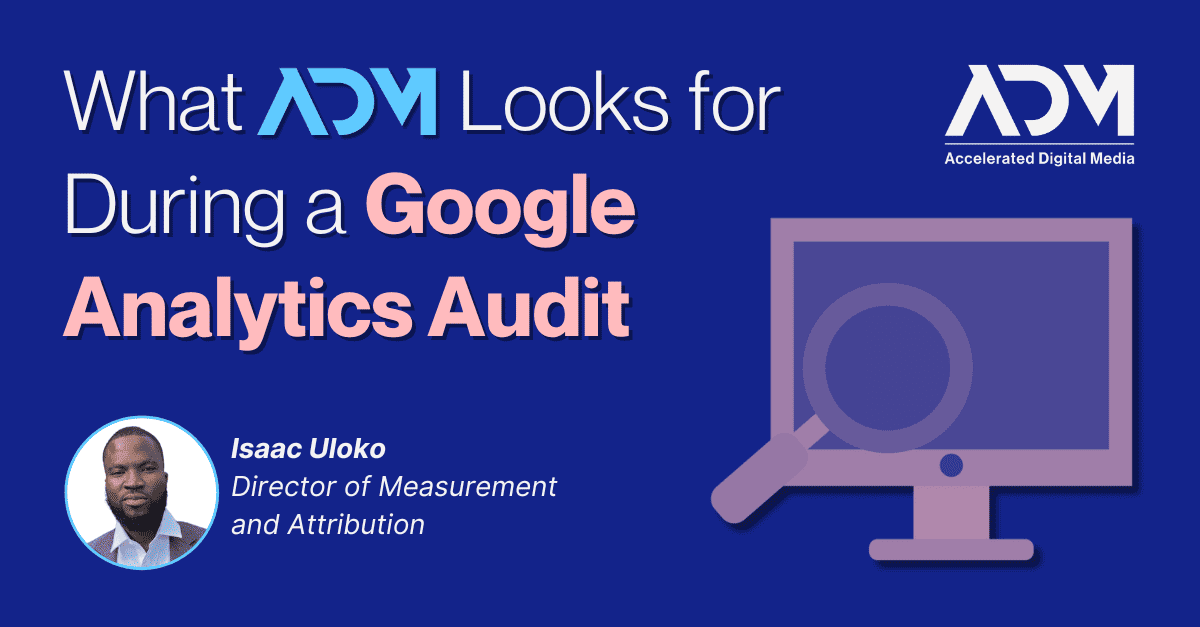Auditing a prospective client’s marketing program is an important first step in any agency relationship. Understanding how they track and measure their marketing data is essential to that process—if you can’t trust the information coming in, it’s impossible to prove that your marketing strategy is working the way it should.
We’ve previously detailed what we look for in a social media audit. In this blog, we’ll explain what ADM specifically looks for when we perform a Google Analytics audit and detail some of the most common problems we encounter and suggestions we provide.
What is Our Goal for a Google Analytics Audit?
The primary goal of an Google Analytics audit is to help a company answer the following question: Can the company trust its historical data? This is fundamental to the other aspects of the audit, because Google Analytics is often a brand’s primary source of truth when assessing its website and ad performance. If the implementation was incorrect or incomplete, they may be receiving questionable data that won’t help them make informed decisions.
To answer this question, we end up having to answer a series of smaller questions, like:
- Is the analytics configuration up to industry standards?
- What is being tracked?
- Is it being tracked correctly?
- Is the data actionable?
To answer these questions, we exhaustively investigate the account and its related implementations.
What We Look for in an Analytics Audit
We have an exhaustive checklist of things we’re looking for when we perforrm an analytics audit. We assess each account based on those deliverables to determine the account’s needs: Sometimes they are in a relatively good standing with just a few fixes needed, while other times they need urgent attention.
There are three main aspects of a Google Analytics account that we are assessing during an audit:
- All Analytics configuration settings within the platform
- The tag implementation for all the events and features that feed into to the Analytics platform
- The company’s channel attribution pipeline
Typically, we have some degree of recommendations for every account we audit. We then discuss the recommendations based on audit findings and proceed with implementation as soon as we enter into a partnership with the prospective client.
We also look at the way the Analytics account is connected to the website, whether hardcoded or through Tag Manager solution. Setting up an analytics account correctly can be tricky for traditional site developers when using a Tag Manager solution, as it requires a custom data layer implementation to accurately capture essential metrics like revenue. While it’s a bit more technically-involved to implement this, it’s 100% recommended.
Common Problems We Encounter in Google Analytics Audits
While each company is different, there is a commonality at the root of many problems we encounter in their Analytics accounts. Typically, issues stem from implementation without a plan. That can be the result of poor setup from the start that was compounded, or from the account changing hands between different internal and agency managers and ending up with a lot of different or unnecessary implementations in place.
Often, that results in inflated or duplicate events, which can lead a company to believe that its marketing is performing better than it is, or leave them wondering why the conversion numbers are growing while the revenue is staying flat. We also encounter a lot of inaccurate channel or campaign attribution as a result of sloppy setup, which again clouds the ability to determine marketing success.
Although some of the analytics tools collect useful data by default, every business is usually different and mostly needs a bespoke implementation plan to be able to track their business goals more accurately.
Do We Approach Every Audit the Same Way?
The answer to this question is: Yes and no. In every account, we’ll ultimately be looking for the same indicators and trying to answer the same question about whether the client’s data is accurate and trustworthy. But different companies collect different amounts of data, which means we’ll have different amounts of evidence to go off of from the baseline. That means we may need to test different aspects of the account more rigorously to reach the right conclusions.
Because every business is different, however, different areas of their account may require special attention. The very first thing we need to understand before beginning an audit is: What are the client’s unique business goals? When we know that, we have the right context to review their analytics tags, what data they collect, what triggers their data collection, and what is being sent to the destination. That’s how we understand whether or not their current setup is serving their needs, and whether they are collecting and verifying the right data to achieve their goals.
The Key to a Useful Analytics Audit
A thorough audit is an essential first step in any agency partnership, and understanding a business’s Analytics implementation is fundamental to assessing its digital marketing success. The most important thing that a business can get out of a Google Analytics Audit is trust in the data that fuels their crucial business decisions. An outside pair of eyes can often find where breakdowns are occurring or opportunities are being missed more clearly.
If you’re exploring performance marketing options and are interested in a thorough, transparent audit, reach out to the ADM team.




